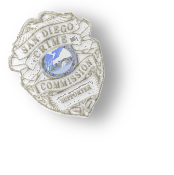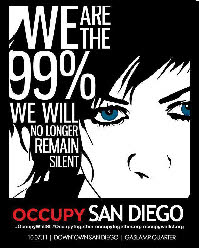
“Connecting Law Enforcement to the Community”


 Occupy San Diego
Occupy San DiegoBoyd Long, Assistant Chief
San Diego Police Department
March 2012
The Occupy Movement actually began with a significant event that occurred outside the United States. In December 2010, the Arab Spring Protests began in Arab countries including: Tunisia, Egypt, Libya, Yemen, Algeria, Iraq, Jordan, Kuwait, Morocco, Oman, Sudan and Lebanon. These protests were organized as an act of civil resistance against those countries attempting to censor the Internet.
The Occupy Wall Street tag was first used on Twitter in June 2011. Social Networking sites such as Facebook, Twitter, MySpace, Google Engage and others have been the primary method for sharing information with regard to the Occupy movement. It was the use of these social networking sites that followers were encouraged to begin the Occupy Wall Street protest in New York. In September 2011, over 1000 people attended the first day of the Occupy Wall Street protest.
Between September and October 2011, the Occupy movement spread to Chicago, Oakland, Los Angeles, Philadelphia, Seattle, Las Vegas, Phoenix, and nearly every other major and many other smaller cities throughout our Nation.
On October 7, 2011, the San Diego Occupy movement began with over 1,700 people participating in a protest against corporate America. The group, who identified themselves as the ninety-
The Occupy San Diego protest started like many others in the past in the City of San Diego. The people gathered in large numbers, speakers spoke, signs were made and someone organized a march. Also, just like other protests from the past, not all identified themselves as Occupy. There were a variety of represented groups at the protest site. In addition to the Occupy protestors, some of those who had joined the demonstration represented anti-
San Diego Police Officers on foot, bicycles and motorcycles had been assigned to the demonstration to provide a safe event and traffic control for the planned march. The police officers were assigned to provide safety and security for the protestors, non-
The group had previously planned to march to the Civic Center Plaza and begin their Occupy protest by camping at the Civic Center. They did march, however they returned to Children’s Park after learning of a religious gathering at the Concourse. By the time the demonstration group returned to Children’s Park, the size had reduced to approximately 300 people. Nearly 200 of those people spent the night in the park.
The following day, the group had planned to march to the Civic Center and begin “Occupying” the plaza. Approximately 400 people gathered for the march from Children’s Park back to the Civic Center. The group remained very peaceful and began setting up tents in the Civic Center. Nearly 200 people spent the night in the Civic Center. A few of the demonstrators indicated they we planning to occupy by sleeping at the Civic Center for an undetermined period of time. Others led police to believe that it was likely a fad and the Occupy movement would conclude within days. Recognizing their First Amendment Right to freedom of speech/expression, the San Diego Police Department took a position of temporarily tolerating the lodging and encroachment laws with a belief that the movement would end in short period of time.
Community members, representatives from labor groups and business owners immediately began bringing supplies to the Civic Center for the participants. It was clear that the Occupy movement had created considerable interest from the community. Community members donated large amounts of food and other supplies to the protesters at the Civic Center. The large amount of perishable food became one of the factors that created the unsanitary conditions at the plaza.
By mid October, it was clear that the Occupy movement was creating an unsafe and unsanitary environment. The group numbers appeared to stabilize at around 150-
The Fire Marshal conducted a walk through at the Civic Center and determined the event was unsafe for those camping as well as employees and visitors to the plaza. The population of tents had grown to nearly 100 and along with other items including tables, chairs, clothing, food, plants to name a few added additional hazards. The Occupy group had created a food service area complete with a propane cooking device, medical supply tent and a library.
Based on the safety hazards, unsanitary conditions and law violations, it was determined that the Occupy protestors could no longer lodge or encroach on the City’s property. The Department prepared and distributed flyers indicating that all tents and personal property must be removed from the Civic Cent no later than midnight. Officers made personal contact and distributed over 250 fliers to those present at the Civic Center Plaza. The flyer indicated the Department’s support of their right to remain and protest however, the flyer mandated the removal of all tents, furniture and personal property as well as the corresponding code sections.
Days earlier, we introduced independent conflict resolution mediators to the Occupy group. The two independent mediators, both professors at San Diego State University were trained in the art and skill of mediation. They were part of a group of mediators brought together during the 2001 Bio Tech Convention that resulted in nearly 2500 demonstrators converging on the City to protest the convention. The program was so successful that the mediators were brought back again for the second San Diego Bio-
In an effort to encourage voluntarily compliance, San Diego Police Officers did not arrive at the Civic Center until 0700 hours the following day where only a few tents remained. Nearly eighty percent of the tents had been removed leaving a smaller group of tents in the area just outside the entrance to the Civic Theater. A group of approximately 35 protestors circled the tents in an effort to dissuade the police officers from removing the tents. The conflict resolution mediators were requested to make contact with each of the protestors to negotiate a peaceful resolution. Within about two hours, the Department made two arrests and removed the tents.
Over the next week, the demonstrators remained at the Civic Center Plaza as well as Children’s Park on a 24-
Officers and mediators continued to advise the protestors individually and as a group that they were violating the penal and municipal codes by storing their personal property at the Civic Center property. Additional tents, canopies, furniture and more personal items were brought into the Civic Center over the next few days. The conditions continued to worsen with mounting spoiled food supplies and outside defecation and urination creating a very unsanitary condition. Because of the unsanitary conditions of the plaza, City work crews were requested to clean and power-
In late October, San Diego Police Officers supported by the San Diego Sheriff’s Department Field Booking Unit descended on the Civic Center Plaza in the early morning hours. A request was made for all persons with personal property to gather their property and immediately leave the area. A temporary free speech protest zone was created along the east side of the Civic Center Theater. Several people immediately gathered their personal property and left the plaza. After waiting a reasonable period of time, another dispersal order was given. Those that refused to leave were arrested for charges ranging from illegal lodging to refusing to leave after the dispersal order was given. A total of 40 people were arrested at the Civic Center Plaza. Officers simultaneously responded to the Children’s Park where 11 persons were arrested for violating the park’s curfew.
Over the next weeks, the group that moved to the grass area along the east side of the Civic Theater began storing personal property including clothing, bedding, furniture and other personal items on the City’s property. A core group of protestors returned to the Civic Center Plaza where they continued to demonstrate in the plaza without tents, furniture or other items of personal property. A group of approximately 30 protestors continued to store large amounts of property along the east side of the Civic Center Theater in violation of the law. After daily education of the law violations along with attempts to solicit individual compliance by officers and mediators, police officers responded and requested all property removed. During that operation several people were arrested.
Since then, the Occupy San Diego Movement has continued with small groups gathering at the Civic Center and Children’s Park. Periodical protests are planned that draw demonstrators to events throughout the City but primarily in the core downtown area.
In the final analysis, during every step of the San Diego Police Department’s response to the Occupy San Diego movement, members of the police department have honored everyone’s right to the freedom to assemble and their right to free speech. The Department has not infringed on anyone’s right to gather and protest. In fact, just like our response to the Occupy San Diego movement, the Department has a rich history of being supportive to any protest group regardless of the message. In cases where a conflict arose, it generally had nothing to do with assembly or speech, it had to do with encroachment of property, illegal lodging or unsafe/unsanitary conditions. The conflict, in every case included a violation of the law. The Department’s fragile balancing act for any police department is to support the rights of the protestors while supporting the rights of those choosing not to protest.
Even though the Occupy San Diego movement has been a significant cost and resource burden to the City of San Diego and the San Diego Police Department, it’s what a law enforcement organization must be prepared to do. There will always be protestors and most will be responsible however, some will commit acts of civil disobedience. In fact these free speech activities are what our country has been built upon. In the Occupy San Diego events, the San Diego Police Department remained tolerant, maintained open communication, responded appropriately and made mediation a priority. We live in a great country and a great city.
###







